Harmonic Evolution Part 1
By Richard Merrick
This paper proposes atomic resonance as a structural guide and predetermining condition for Darwinian evolution theory. Recent studies on the mesoscopic structures of water and carbon, together with the latest geometric DNA mapping theories, suggest that life emerges and grows according to predictable harmonic patterns found in organic chemistry, preserving and propagating specific atomic geometries into living organisms. Based on this and relevant neurophysiological research, a harmonic Gaussian interference model for cellular entrainment is presented to explain the origin of common organic geometries, including cardioid, ellipsoid and spiral primitives, as well as 3-fold exo- and 5-fold endo-skeleton structures. From this, a recursive harmonic Hilbert space is defined for use in evolutionary classification, physiological analysis and organic simulations. Examples are provided, including a step-wise analysis of the human body.
Avenues for additional research are discussed, including application of harmonic Gaussian interference models to cosmology, cognition, medicine, social theory and philosophy.
1. Introduction
To find our deepest connection to Nature, we need look no further than the geometry of the human body. (Fig. 1) It is at the apex of Creation, reflecting the beauty of the cosmos and embodying the order of its physics. Yet in spite of this self-evident truth, we still have very little understanding about why our bodies are shaped the way they are and how that might be connected with the evolution of perception and human consciousness.
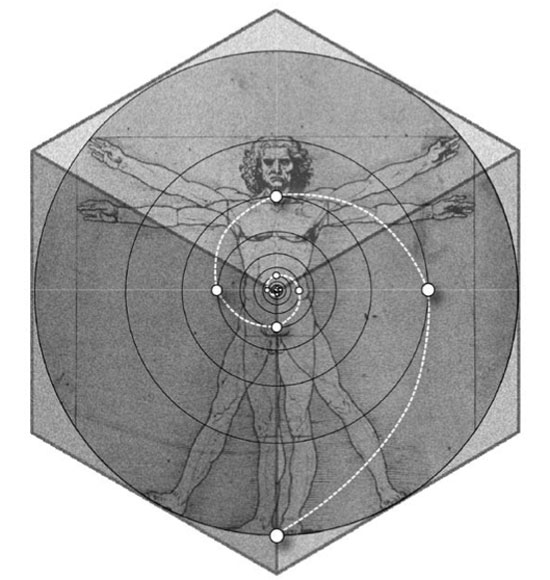
The contemporary Darwinian view from the fields of biology and anthropology hold that the appearance of life on Earth was driven by chance from the molecular level up, then adapted over time to survive better in a hostile environment. [1] Indeed, the theory of evolution depends exclusively on natural selection and survival of the fittest (with the occasional random mutation) to explain the shapes of the tiniest plants and organisms up to the largest animal. [2, 3] The theory is probably best summed up by the rallying cry of the neo-Darwinist ‘If we could somehow restart life on Earth (or another planet) from the beginning, it would probably turn out completely different.’
As things stand today, Darwin natural selection combined with Mendelian inheritance has become the only generally accepted scientific explanation for life on Earth. Without a better explanation, most scientific-minded people choose this theory as is, defending it without question in spite of the fact that it cannot tell us, for instance, why we have five fingers instead of six or a wave-like spine rather than a straight one. Everyone knows instinctively that something is missing in evolutionary theory to answer such questions, but what could it be?
Re-thinking Evolution
What if there is a less obvious but universal property in Nature that physically guides evolution from somewhere beneath the environmental process of natural selection to carve the basic shapes of life? What if life is as much a function of the way atoms bond with one another as it is genetic mutation and selection?
Common sense alone tells us that for natural selection to be the only explanation for why life appears as it does, the fossil record should show many times the variations found. For instance, since eight legs work so well for a spider, shouldn’t we find fossils of higher organisms with eight legs capable of outrunning, outmaneuvering and even out-boxing their four- legged predators?
Or, how about only three legs, which might have enabled a more efficient cardiovascular system? Where are all the ‘failed’ animal fossils with entirely different appendages, re-arranged internal organs, extra joints that offer greater flexibility or even eyes in the back of their heads? Wouldn’t some of these have been more survivable than many animals today?
Yet for some unexplained reason, fish, reptiles, amphibians, birds, mammals and even dinosaurs all ended up with the same basic skeletal structure consisting of a wave-like spine, cardioid- shaped rib cage, single head and four limbs. While natural selection does imbue each of these creatures with a particular anatomical variation or morphology, this basic 5-fold archetype was the one and only internal skeletal template that emerged as life evolved in and out of the sea.
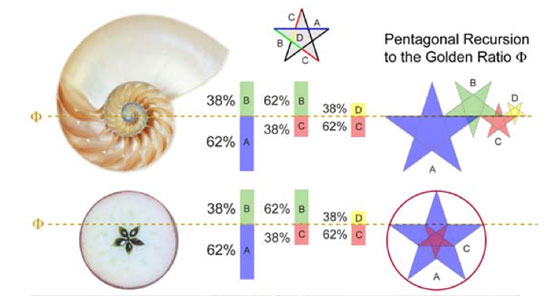
Similarly, insects are a morphological adaptation of a single 3-fold exo-skeleton template comprising a head, thorax and abdomen. These, too, appear to have occurred during the transition to land and air from simpler sea creatures.
As for invertebrates like jellyfish all the way down to bacteria and viruses, all manifest a morphology of simple periodic geometries, such as spheres, rings, toruses, tubes, helixes, stars and even icosahedrons. Plants and fungi are much the same, branching or spiraling as groups of about 62% and 38% into the extruded regular geometries of fruits, vegetables and flowers (Fig. 2).
But for natural selection to favor survivability, shouldn’t we expect to see fossils of plants that once branched randomly (or equally) or land animals with much more diverse features? Shouldn’t the animals alive today have descended from more efficient and fiercely competitive, anatomical archetypes?
The fact is there is nothing in the theory of evolution and the fossil record that can explain any of this, any more than it can explain why leaves are not square or why fruit assumes the shape of regular geometries. So, what else could be at work to guide the evolution of life?
2. Atomic resonance as a framework for life
All life on Earth is composed mostly of carbon-12 and water. This is the case because carbon-12 bonds or resonates with more simple elements than any other element in the universe. It is for this very reason that carbon-12 is the international standard for atomic weight and all other elements are measured against it. With 6 protons + 6 neutrons in its nucleus and 6 electrons orbiting in two shells, carbon-12 exhibits the lowest possible energy of all the elements and is said to be ‘unbound’, thereby creating the most stable atomic geometry possible (Fig 3). When mixed with water, carbon-12 creates endless chains of sticky amino acids capable of crystallizing into life.
This idea of life as a crystallization process is a good one because just as minerals align under pressure into lattices, coils of amino acids fold under pressure into three-dimensional protein structures, aligning into the familiar helical lattice of DNA. It is the geometric pressure of hydrogen atoms in water that helps create the lattice and give DNA its twist.
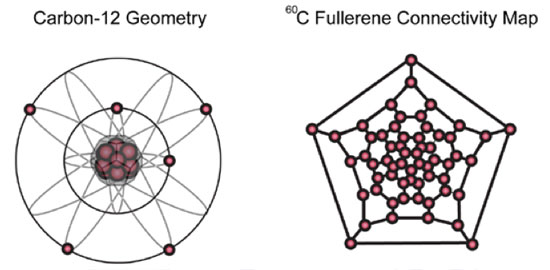
In recent molecular studies of water, biochemist Martin Chaplin found that water organizes itself naturally into a lattice of icosahedral clusters, just as Greek philosopher Plato proposed more than two millennia ago. Water really does resemble the 12- pointed, 20- faceted geometry of an icosahedron.
The water lattice begins as 4-fold tetrahedral units of 14 water molecules, aligning into 20 clusters to create the geometry of a 280-molecule water icosahedron (Fig 4). This structure then assumes a variety of stable, geometric sub-structures (such as its complementary dodecahedron) that form into even larger superclusters. At this mesoscopic scale of water, molecules arrange themselves into a 2-dimensional connectivity map of a regular 5- fold pentagon. [4a-f]
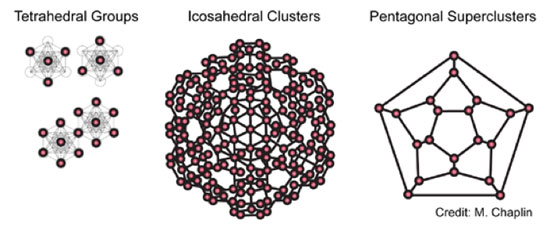
When the 5-fold icosahedral superclusters of water is then combined with the complementary dodecahedral structures of carbon, something very interesting occurs – they resonate with one another to produce the characteristic geometry of life. There is nothing random or arbitrary about this – it is an inevitable outcome of the physics of harmonics acting at the atomic level. Carbon vibrates or resonates with itself and other simple elements to form a wave-like spine while water acts to deaden or ‘damp’ everything into a pentagonal framework.
The role of atomic resonance in creating organic shapes was demonstrated in another recent study showing the first step of enclosure needed for a living cell occurs from a geometrical folding of carbon molecules. In a 2006 publication of the American Chemical Society entitled, Tb3N@C84: An Improbable, Egg-Shaped Endohedral Fullerene that Violates the Isolated Pentagon Rule, it was reported that a large, Fullerene, carbon-84 allotrope constructed its own egg- like cage when two adjacent pentagons in the carbon molecule became fused together in a reaction with terbium (Fig 5). [5]
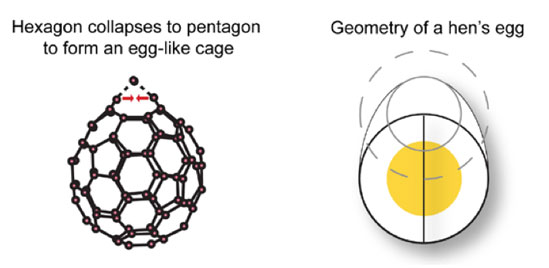
Discovered by a combined team from the University of California, Virginia Polytechnic and Emory and Henry College, this was the first indication that the regular soccer ball geometry of hexagons and pentagons in a large carbon Fullerene could wrap itself into an egg-like cage by reacting with another atom, thereby producing a uniquely organic geometry known as a quasi-crystal.
This discovery could help answer a lot of questions. It may explain how amino acids ‘learned’ to form cellular containers to protect themselves from the environment. It could even offer a reasonable explanation for how ribcages came to form around vital organs in all vertebrate animals. It suggests that the atomic balance between pentagonal and hexagonal molecular geometry is the primary cause for the enclosure process of life, rather than some mysterious external selection process. The egg clearly came before the chicken!
In each of these studies, we can begin to see how evolution could be guided by geometric harmonies at the mesoscopic scale of carbon-water bonding. The 5-fold inward-damping geometry of water provides a kind of pressurized container for the outward- resonating carbon-12 atoms, bonding out of inanimate elements into living harmonic crystals. The entire process could be described as a kind of biological music resonating out of a finely tuned atomic framework constructed primarily from water and carbon atoms.
From the perspective of atomic resonance, Darwinian evolution becomes a veneer of adaptation that depends on pre-existing and universal harmonic laws intrinsic to Nature. Simple animals resonate into uni-body and 3-fold carbon-12 shapes while more complex forms succumb to the 5-fold damping pressure of water, branching out at approximated Golden Sections into pentagonal clusters, such as roses, starfish and the human anatomy. As the most resonant life form of all, we humans exist at the razor’s edge of atomic harmony – perfectly balanced in 12:5 proportions by Nature – to achieve consciousness and ponder our own existence.
Perhaps it is time to update Darwin’s 19th century theory of evolution to include atomic resonance acting in concert with natural selection. And maybe the first goal for this new theory of harmonic evolution should be to understand how carbon-water geometry is preserved in the genetic code.
3. Evidence of geometric encoding in DNA
A recent paper by physician and researcher Mark White, entitled The G-ball, a New Icon for codon symmetry and the Genetic Code, proposed that the codon table of the genetic code follows the shape of a 12-faced pentagonal dodecahedron.
Since there are exactly four nucleotides in DNA that combine in sequences of three to produce 64 codons (43 = 64), White suggested that the genetic code organizes itself into the shape of tetrahedrons, which then combine into the shape of a spherical dodecahedron – exactly like clusters of water molecules (Fig 6).
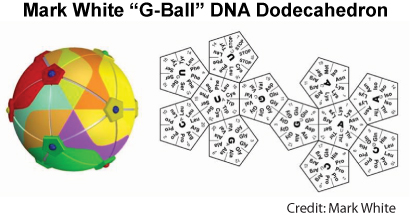
Following the equilateral genetic structure predicted by Russian physicist and cosmologist George Gamow, White explains how the 20 edges of a dodecahedron (or 20 triangular faces of its dual icosahedron) can be used to represent the 20 standard amino acids in DNA. The amino acids are then assigned locations in the geometry according to their water affinity (how much they like or dislike water).
From this, protein bonds into sequences of amino acid tetrahedrons, forming into a 12-sided dodecahedral framework that is then twisted by hydrogen around a fixed polar backbone to produce the 10-step spatial symmetry of the DNA double helix (Fig 7). [6]
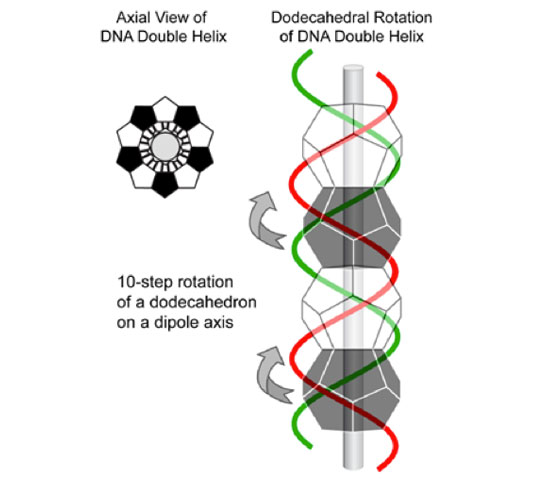
Another study by Chi Ming Yang at Nankai University in China claims to have also found a quasi-periodic, egg geometry in the human genetic code, paralleling Mark White’s G-Ball model.
Derived from the same building blocks of 20 standard amino acids and 64 tri-nucleotide codons in DNA, Yang found a cooperative ‘vector-in-space’ addition principle that stretches into an ellipsoid or egg-like shape called an icosikaioctagon (Fig. 8). Not surprisingly, this geometry was determined to have originated as five ‘stereochemical’ growth stages over a period of millions of years. [7]
So, when we combine Yang’s quasi-periodic model with White’s G-ball model, we arrive at a structure common to all forms of biological life – a 5-fold ‘egg’ with a 12-fold ‘yolk’ inside. Through the harmonic physics of atomic resonance and damping, Nature has engineered DNA with its own eggshell container to protect the geometric resonance of life over time.
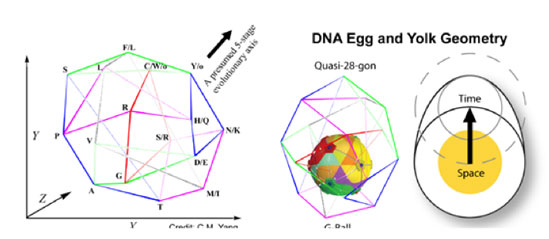
This can be understood as a natural interaction between space and time. Water creates a spherical container for carbon-12 resonance, allowing only whole number harmonic structures to form in the yolk. Around this, a pentagonal water crystal forms to protect the yolk and gestation of life. This cage is then shaped into an egg as the pentagonal crystal recurses toward the square root of five and the yolk region is displaced along a polar axis. This causes the egg to assume the quasi-crystalline shell dimensions of Φ3 long x 2Φ wide, which reduces to Φ2 / 2 = 1.3090165.
While the idea that DNA could be encoded geometrically as an egg may seem ‘improbable’ to some, the idea appears to predate even Pythagoras. As a symbol of balance in all life, early natural philosophers seemed to understand the egg as an instance of the Golden Mean – cubed in its length and doubled in its width, derived from the square root of 5 in a pentagram.
As example, Aesop’s fable of The Goose That Laid the Golden Eggs, based on a much older Egyptian story, probably has more to do with how life grows harmonically inside a golden-proportioned egg container than it does the precious metal. In an ancient worldview founded on the physics of music, the golden egg could have been seen as a pentatonic container for a dodecahedral yolk, creating a living 7-fold diatonic animal in between (‘dia-tonic’ means ‘thru the body’).
But even with the growing evidence of harmonic structures in DNA, one last puzzle remains to fully understand how DNA unfolds itself in space during reproduction. How exactly do the carbon and water atoms in DNA self-organize into larger organisms? And while the resonance of amino acids clearly start the crystallization process at the mesoscopic level of water and carbon, what can we say enables this process to continue outward into the macro structures of highly evolved life?
4. Space as a resonant container
It is a well-known fact that sound will produce regular geometric patterns when particles of powder are vibrated on plates or inside liquid containers. Known as cymatics (from the Greek word for ‘wave’), researchers such as Ernst Chladni in the 18th century and Hans Jenny in the 20th have shown how harmonic waves will reflect in containers to form circles, triangles, pentagons, hexagons and other, more elaborate, mandala-like patterns (Fig 9).
As might be expected, the simplest cymatic patterns occur inside a circular or spherical container, always aligning to a single line of symmetry. As waves resonate into standing waves, different harmonic frequencies combine to form regular patterns by crossing one another at whole number proportions. The same thing can be said to occur in the atomic substratum of DNA as harmonics guide cell mitosis. The only difference with DNA is space (together with gravity and atmospheric pressure) act as the cymatic container.
According to quantum chromodynamics, the vacuum of space is structured as a non-compressible, stationary cubic lattice.
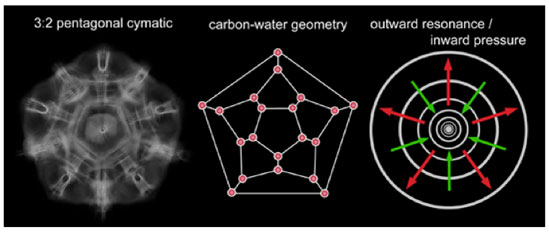
One interpretation of this lattice is as a field of nominal Schwarzschild black holes comprising a field known as the Schwarzschild lattice. Within this definition of quantized space, atomic particles (bosons) are said to center on spiraling vortices (called a Flamm paraboloid) in a given cell of the lattice, forming geometrical patterns in its nucleus and orbiting electron shells. [8]
So, when we now consider carbon and water atoms resonating together inside a geometrical space lattice – pressurized into spherical bubbles by Earth’s gravity and atmosphere – the atoms and molecules in living tissue would naturally entrain and resonate synchronously into larger and larger cymatic patterns.
For life, it must be the quantum structure of space and the pressure of its gravitational ‘egg’ that together have the ‘know how’ to arrange vast numbers of resonating molecules into life-size crystalline structures. In this way, living cells would dynamically self-organize into stable geometries much like powder vibrated inside a spherical water container.
In the container of a human body, the energy of resonating atoms, molecules and cells would have little choice but to entrain into a reflected harmonic standing wave, rippling outward from the 12 x 2 = 24 vertebrae of the spinal column with less and less energy tothetipsofour5x2fingersand5x2toes.Hereagainwefind the body described as a 12 : 5 dodecahedral proportioned carbon- water crystal resonating under intense gravitational pressure into the container of the quantum chromodynamic lattice. It is not a matter of metaphysics to say that life is crystallized light formed by spherical harmonics in a structured space.
The Universal Harmonic Pattern of Life
This discussion now brings us to a definition of life based on the physical process behind the formation of harmonics in a circular or spherical container. Properly defining this process is essential in understanding the physics guiding evolution and the patterning process of organic growth. As we will see, the geometry of life can be traced back to one universal pattern of harmonic interference.
Not too surprising, this universal pattern can be easily found using a ‘Blackman spectral analysis’ of two musical tones diverging at a constant rate from unison upward to an octave (Fig. 10). Reproduced here with a built-in function in Adobe Audition®, the analysis reveals the spacing and size of resonant gaps that form naturally according to small whole number harmonic ratios, just as Pythagoras had discovered over 2,500 years ago. Each gap corresponds to a simple musical proportion, such as the 3:2 ratio of a perfect fifth, 4:3 perfect fourth and the highly resonant 5:3 major sixth – the widest gap of all.
To be clear, this is not a random, variable or contrived pattern, but the one universal pattern of interference produced by all harmonic standing waves as they vibrate through any medium.

This spectral pattern is not limited to sound only, but exists everywhere harmonics form, including electromagnetic fields, laser light, musical tones, natural vibrations in the Earth, the spacing and sizes of planets in our solar system and the coherent cellular structures of life. We can represent it mathematically using a statistical curve called a first-derivative Gaussian distribution (shown in red in Fig. 10).
You will probably never learn in school how important this harmonic curve really is, but it is present everywhere in Nature. It approximates the change in the number of spots on the Sun, describes the change in diameter of blood vessels in living organisms and estimates the thickness of tree bark as it reduces upward in a tree, to name but a few. As a representation of the velocity change in a Gaussian ‘normal distribution’ (or ‘Bell Curve’), this one function is the foundation of probability science and the very cornerstone of modern statistics.
But while most scientists accept and use this distribution and its strange equation without question, some of us might still wonder what physical process is at work underneath it to cause harmonics to always self-organize in this way. How can we understand what this Gaussian equation is trying to tell us about Nature?
When we stop to consider the curve from a philosophical perspective, we can begin to understand the basic principles underneath it, driving the harmonic patterning process. A more intuitive and organic description of the resonance pattern can be expressed as the square of the linear harmonic series as it is curved (one might say carved) by the Fibonacci series (Fig. 11).
As we see in the figure, the interference curve is a natural byproduct of harmonics as they resonate and damp one another. It results from the square of the first twelve frequencies of the harmonic series, as {1, 4, 9, 16, …, 144}, divided by the first twelve Fibonacci frequencies {1, 1, 2, 3, …, 144}. This is summarized by the Harmonic Interference function in the figure, expressing the balance between spatial resonance and temporal damping in a simpler, more beautiful symmetric form.
With this one equation, we can see how Nature balances itself between the finite and the infinite, harmonizing a closed resonating circle or harmonic wave with an open Fibonacci spiral. It represents nothing less than the geometric harmony of π-squared divided by the golden ratio Φ, otherwise known as the ‘squaring of the circle.’
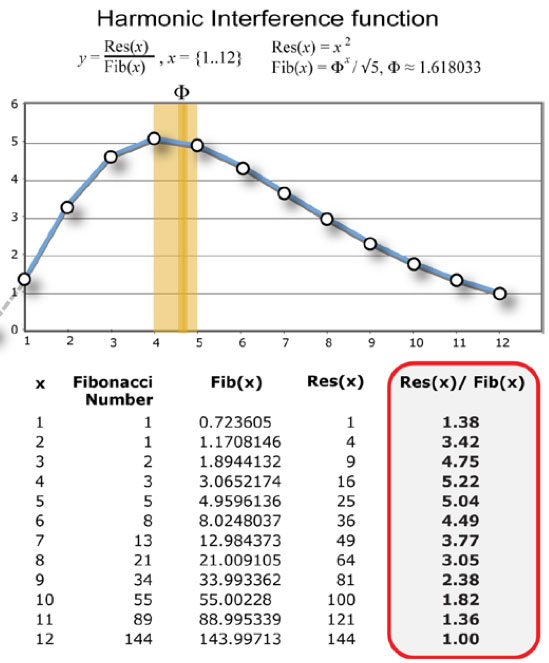
While this may all seem a bit abstract at first, its relevance to understanding how harmonics guide the evolutionary process will begin to become clearer after a minute or two. Consider first the fact that spherical stars and planets form out of spiraling clouds of plasma. Then consider that life also grows out of a spiral. We see this in the unfolded Fibonacci spirals of tree branches, the spiral of a chambered nautilus and the spiral of a human embryo. In a very real and physical way, everything emerges out of infinity as a spiral, eventually stabilizing into a harmonic wave or sphere.
So when we now take this harmonic interference pattern and geometrically square it again, folding it back upon itself as if reflecting inside a circular container, we arrive at perhaps the most important geometry in the universe and the one guiding pattern at work in the evolution of life – the symmetrical Reflective Interference Model (Fig. 12).[9]
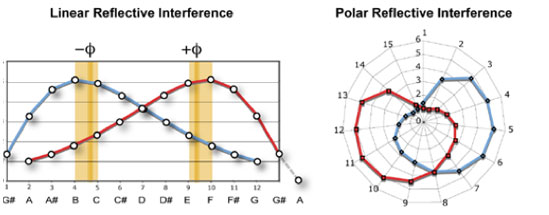
Formed from the harmonic mean between a circle and a spiral, this organic-looking curve is the shape life assumes as it evolves into higher and more complex organisms. We can prove this by observation.
First of all, DNA and all forms of life always orient around a polar axis (see Fig 13). In humans and other animals the primary axis becomes the spine while for plants it is the trunk or stem.
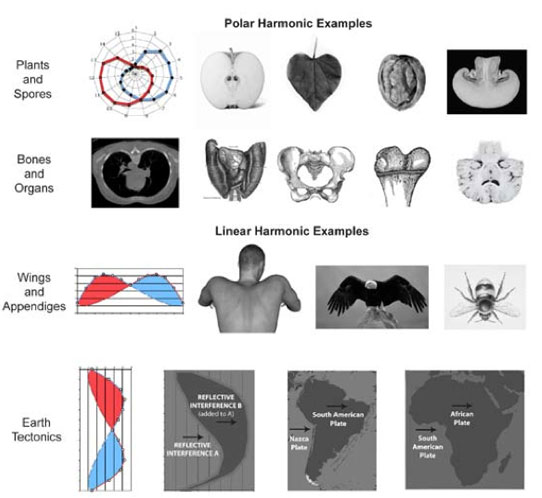
As cells grow and resonate outward from their polar axis, the Polar Reflective Interference Model tells us that they resonate or explode outward (in slow motion) as a circle or sphere, but then begin to lose energy and damp back inward, spiraling and twisting back toward the polar axis. As this reflects in two opposing directions, a heart or cardioid shape forms with an intersecting almond-shaped region called a ‘mandorla’ in the center. We see this geometry in such things as plant leaves, fruit, bones and internal organs, such as the brain and cardio-respiratory system. A MRI cross-section of the chest is probably the most impressive example, revealing how the heart nests inside the mandorla.
Sometimes this harmonic pattern runs along a line instead of around a polar axis. Examples of Linear Reflective Interference can be found in such things as wings, shoulders and even the Earth’s spherical tectonic plates (stretched at the equator and narrowed near the poles). The most noticeable example of linear harmonic geometry is the double Gaussian shape of human breasts. As the organ that generates more energy during lactation than any other organ (including the brain), female breasts act as a damping container for cellular resonance either side of the heart. Nipples are a function of this resonance, forming near the apex (or max velocity) of the interference curve, opening at golden ratios to the surface of the body (Φ and -Φ in previous Fig. 12). All sentiment aside, mother’s milk is a physical expression of the heart’s harmonic resonance.
This same harmonic interference pattern is found repeated at different scales and orientations throughout the entire human body. Yet, it is not immediately apparent why the pattern configures itself the way that it does. Is it strictly random, a result of mutation and natural selection as the Darwinian theory of evolution claims, or is there an even larger harmonic pattern involved?









